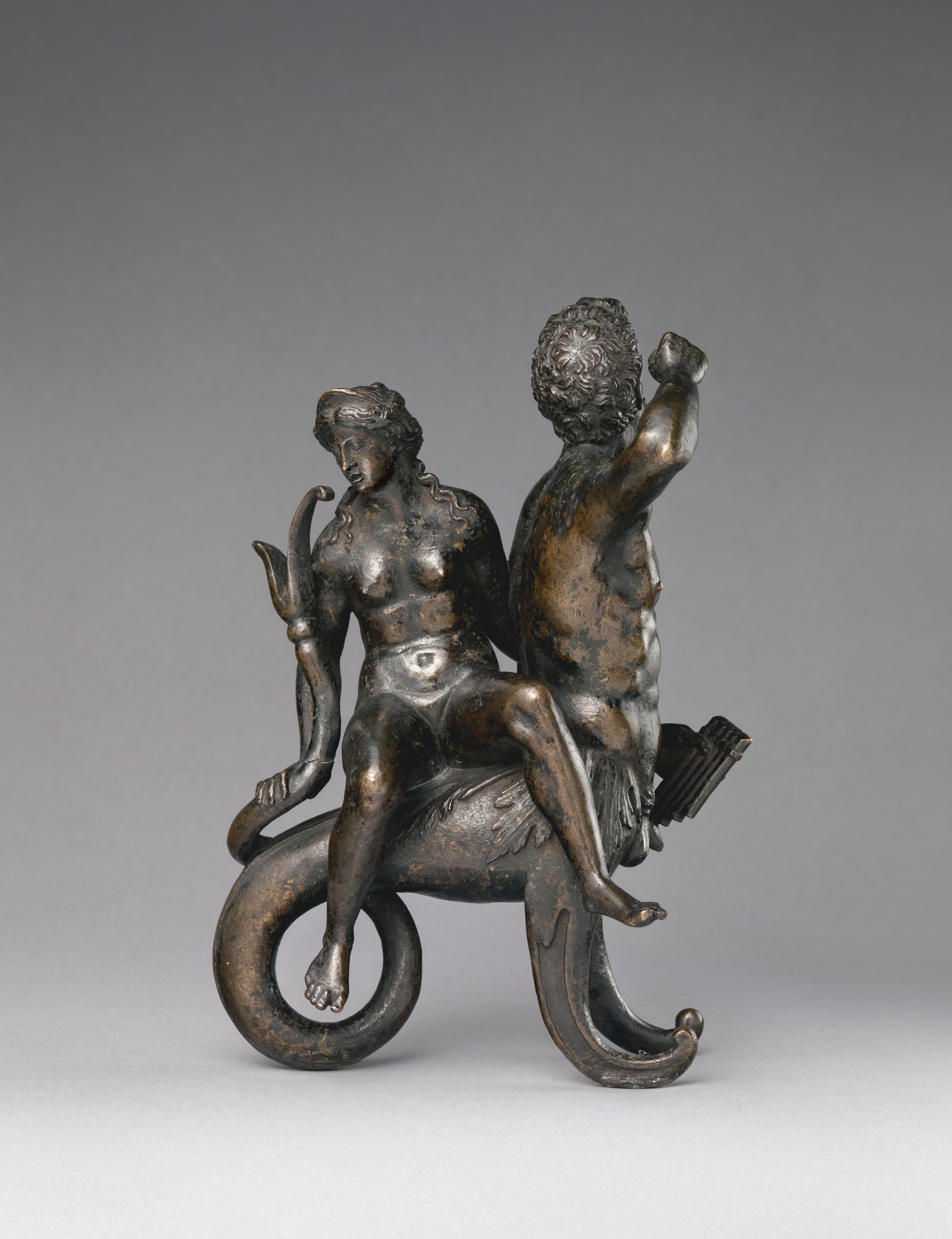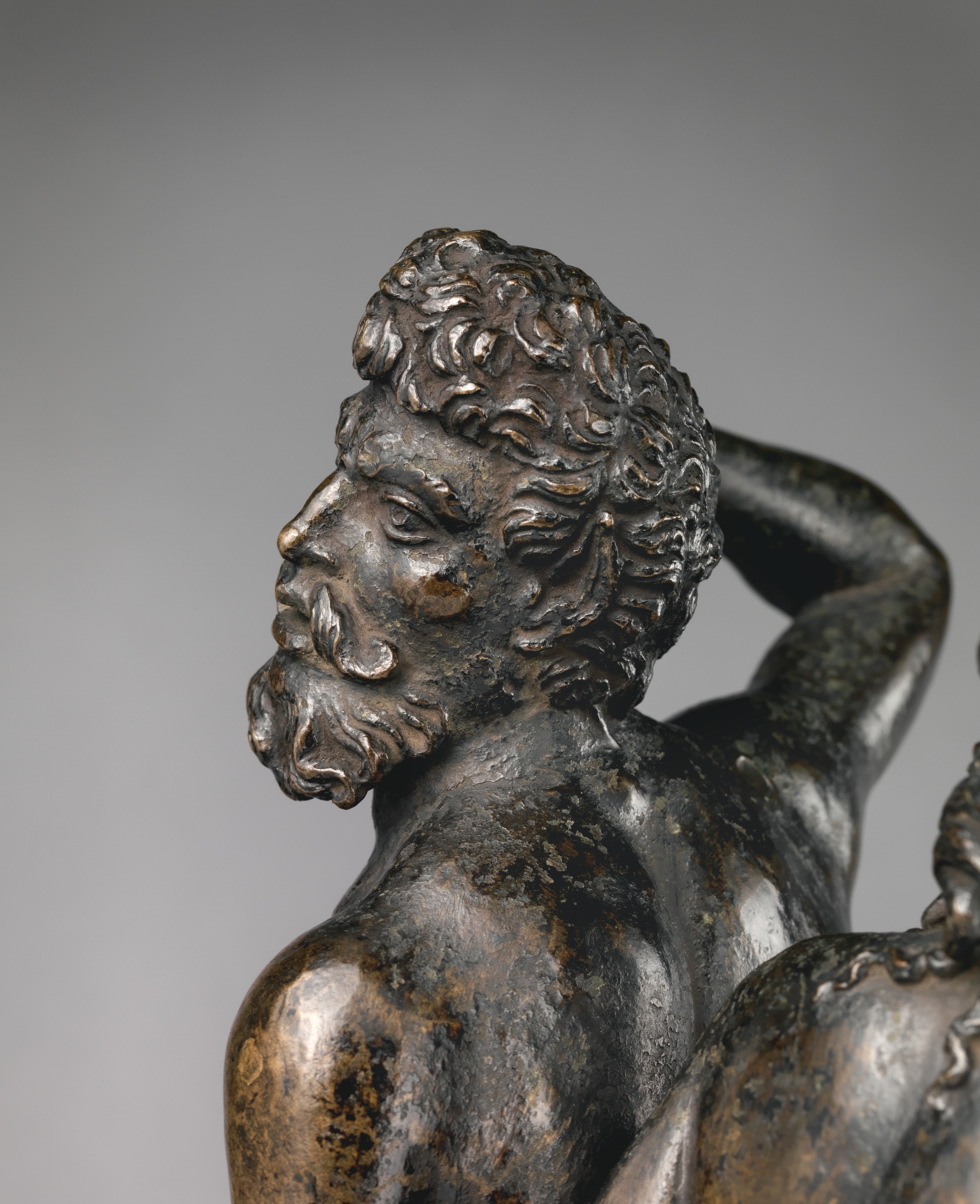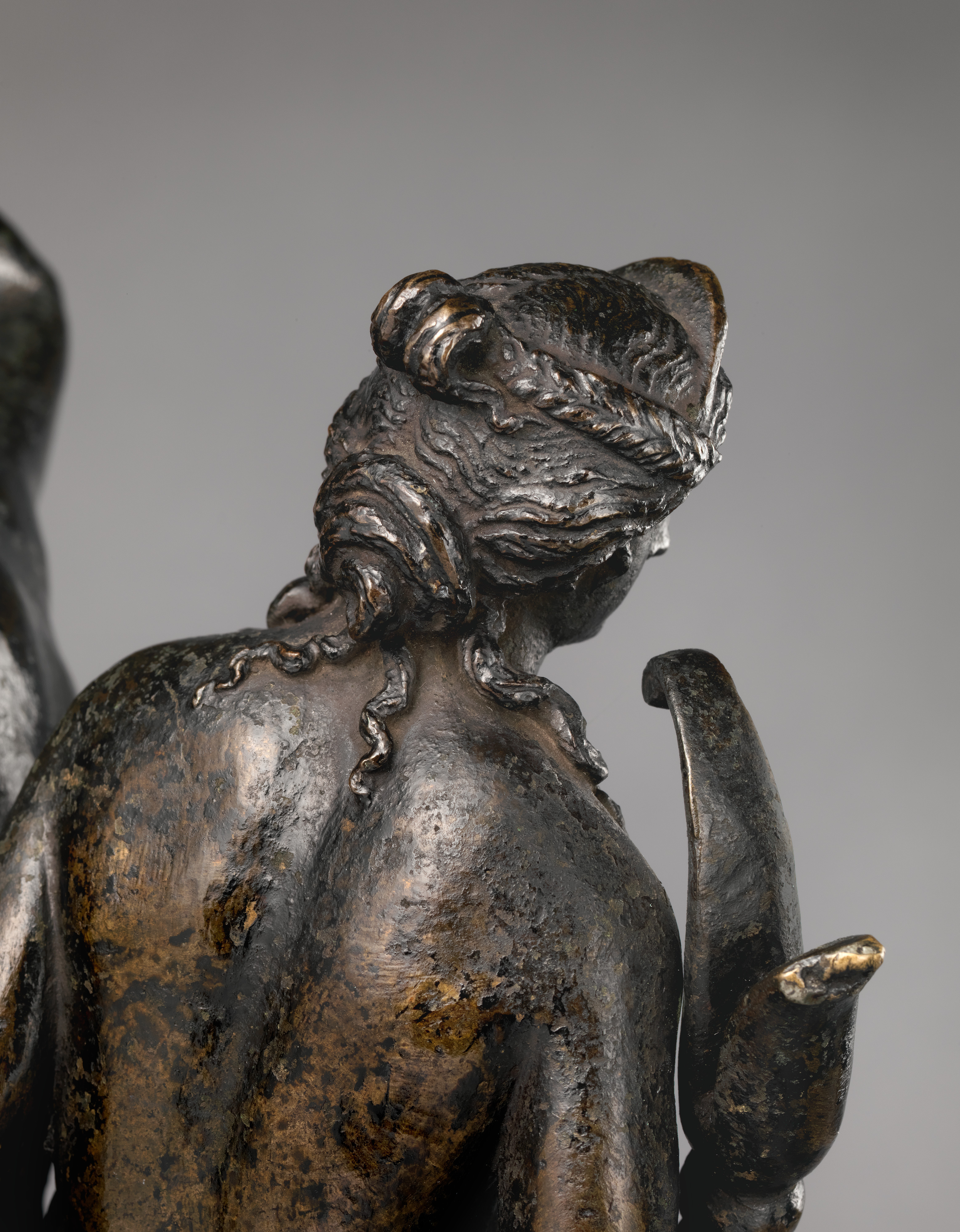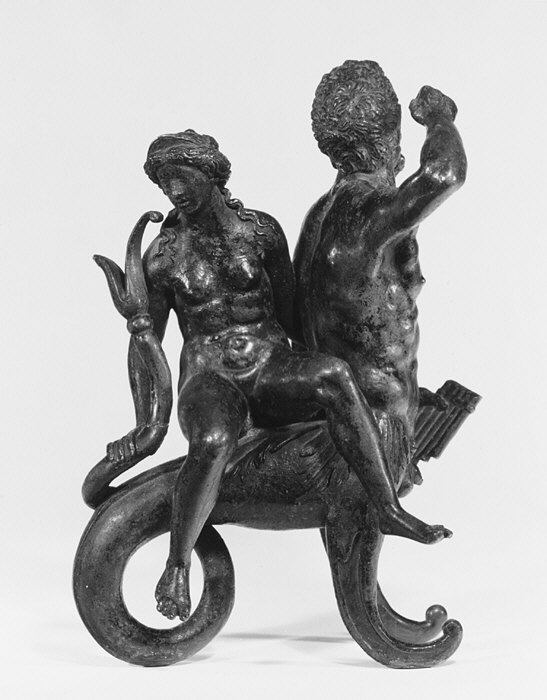Triton and Nereid
Possibly workshop of Andrea Briosco, called Riccio Italian
A delicately proportioned woman rides on the back of a muscular male creature that is human from the waist up with scroll-like front legs and a leafy-finned, serpentine body. The pair are Greco-Roman sea deities. The female is a Nereid, or ocean nymph. The male figure, often identified as a Triton, is more accurately a sea-centaur (ichthyocentaur), a mythological hybrid being with the upper body of a man, equine front legs, and the lower body of a serpent.[1] Frequently represented on classical reliefs, Triton and Nereid figures appear as a lone couple on ancient gems,[2] and on marble sarcophagi as boisterous crowds fighting sea battles or accompanying triumphal sea processions (marine thiasoi).[3] However, Triton and Nereid pairs are not the isolated subjects of classical statuettes. This bronze group is a Renaissance invention made in emulation of the antique while at the same time freely departing from it.
Creating independent statuettes that were inspired by classical and contemporary relief sculptures recalls the compositional approach of the Paduan bronze master Andrea Riccio.[4] The formal similarities between the Triton and Nereid group and Riccio’s other bronze figures have led scholars to credit the conception of this model to the master. However, none of the surviving casts of the Triton and Nereid exhibits the highly distinctive hammering in the metal that is a hallmark of Riccio’s bronzes, and only the example in the Bargello has been tentatively related to Riccio’s shop.[5] The Met Triton and Nereid is much more summarily modeled than its Bargello counterpart; it lacks the decorative pricking on the Triton’s legs and the refined tooling on the figures’ features and hair. An unknown, presumably Paduan sculptor who might have had access to Riccio’s models probably fashioned our bronze after the master’s death.[6]
Twelve versions of the Triton and Nereid statuette are known.[7] The number of surviving bronzes suggests that the motif resonated with audiences in the Veneto, where marine thiasoi were emblematic of Venice’s relationship to the sea.[8] Triumphal sea processions adorn the monumental bronze flagpole bases erected in 1507 in the Piazza San Marco.[9] Cosmological sea-thiasoi reliefs are the foundational scenes at the foot of Riccio’s towering bronze Paschal Candelabrum (p. 00, fig. 13c) in the Basilica of Saint Anthony, Padua.[10] The central civic importance of such public imagery might have encouraged the development of the Triton and Nereid statuette for the private domestic sphere.
The distinctive figure types, poses, and gestures of the Triton and Nereid ultimately derive from a fragmentary sea-triumph sarcophagus in Rome that was well known during the Renaissance.[11] On it, as on most classical sarcophagi, the Nereid passengers are depicted as if in mirror image, one shown from the front, the other from the back. Both views are combined in this engaging statuette, which is composed to feature equally well from either side whether placed high on a shelf or low on a table (the most common domestic locations in which bronzes were displayed). The Triton’s dramatic gestures and turn of the head—presumably toward the viewer—suggests the statuette was designed to be seen principally from the male side, affording a modest view of the Nereid’s graceful back. When placed low on a table, its complementary play between the Nereid, seen from the front, and her much larger male companion is revealed. Her classically idealized sensuality contrasts with the Triton’s monstrous hybrid muscularity. Her graceful, balanced pose and calm introspective expression temper the Triton’s bellicose posturing and belligerent outward gaze.
The Triton looks up sharply to his left and opens his mouth, revealing his teeth. He originally held an object in his raised right hand; the fingers and thumb curl around the rather large insertion hole. The Triton’s gesture is consistent with brandishing a weapon, as seen, for example, in Mantegna’s famous late fifteenth-century engravings of the Battle of the Sea Gods.[12] In his lowered left hand, the Triton holds a syrinx (panpipes), an attribute of the deity Pan, and one common to the followers of the god of wine and ecstatic transport, Bacchus. During the Renaissance, sea triumphs and Bacchic processions symbolized physical, mental, and spiritual transitions, and thus are often represented together.[13] In the Triton and Nereid, the relationship between these subjects is distilled with utmost refinement, granting the small bronze the capacity to be interpreted in a variety of ways depending on the needs and moods of its viewers. In a scholar’s study or collector’s cabinet, for example, the lively bronze figures might have been perceived to embody the inspired Bacchic energy so necessary to creative thinking. On the other hand, contemplation of the Triton and Nereid’s journey might have evoked the classical sea processions on sarcophagi that symbolized the spirit’s transit to eternity.
-DA
Footnotes
(For key to shortened references see bibliography in Allen, Italian Renaissance and Baroque Bronzes in The Metropolitan Museum of Art. NY: The Metropolitan Museum of Art, 2022)
1. Dimitrios Zikos and Denise Allen in Allen 2008a, p. 104, cat. 2, where it is also noted that the Triton’s abstract, scroll-like forelegs were probably inspired by grotesque decorations in manuscript illuminations. For the relationship between Renaissance hybrid creatures and grotesque decoration, see Hammeken and Hansen 2019.
2. For example, MMA, 06.1205.
3. For marine thiasoi sarcophagi known to the Renaissance, see Bober and Rubinstein 2010, pp. 142–47.
4. See Allen 2008b, pp. 23–24.
5. Bargello, 353 B; see Allen 2008a, pp. 108–9.
6. The alloy is a brass with some lead, tin, arsenic, silver, antimony, iron, and nickel. R. Stone/TR, 2012.
7. See Jestaz 2005, p. 153 n. 122.
8. For the importance of the Triton and Nereid motif in the Veneto, see Luchs 2010.
9. See Wolters 1996.
10. See Banzato 2008b.
11. For this sarcophagus and its numerous reflections in Renaissance art of the Veneto, see Bober and Rubinstein 2010, pp. 144–45, no. 100, figs. 100i–ii, 100a–b.
12. MMA, 18.12 and 1984.1201.4.
13. For a discussion of the interrelationship between Bacchic and marine-thiasoi imagery with a particular focus on Mantegna’s engravings of the Battle of the Sea Gods, see McStay 2014, pp. 443–59.
Due to rights restrictions, this image cannot be enlarged, viewed at full screen, or downloaded.
This artwork is meant to be viewed from right to left. Scroll left to view more.






